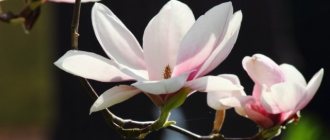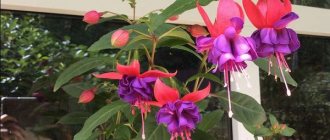Author: Elena N. https://floristics.info/ru/index.php?option=com_contact&view=contact&id=19 Category: Houseplants Published: February 05, 2019Last edits: April 17, 2021
- Growing from seeds
- Calceolaria rugosa (Calceolaria rugosa)
The plant calceolaria (lat. Calceolaria) belongs to the genus Calceolariaceae of the Norichnikov family, although English scientists distinguish the genus Calceolariaceae into a separate family. There are about 400 plant species in the genus, native to Central and South America. Translated, “calceolaria” means “slipper.” Representatives of the genus are herbaceous plants, subshrubs or shrubs; among them there are perennials, biennials and annuals, but in indoor culture, Calceolaria flowers are usually grown as annual herbaceous plants.
Planting and caring for calceolaria
- Flowering: in April or May for 3-5 weeks.
- Lighting: partial shade (north, north-west or east window).
- Temperature: no higher than 15˚C.
- Watering: constant, so that the soil in the pot is slightly moist all the time.
- Humidity: very high. It is recommended to keep the plant on a tray with wet pebbles or line the pot with peat and keep it moist at all times. It is not recommended to spray the plant.
- Feeding: two weeks after planting and before flowering begins, with mineral fertilizer solutions twice a month. In autumn and winter, fertilizing is not applied.
- Pruning: after flowering.
- Dormant period: after flowering for 1-1.5 months.
- Transplantation: do not replant. The lifespan of the plant is 2 seasons, then the plant no longer blooms.
- Reproduction: seeds, cuttings.
- Pests: aphids, whiteflies.
- Diseases: gray rot.
Read more about growing calceolaria below.
Light intensity
This is not to say that calceolaria loves shade. She needs a lot of light. However, direct rays are not desirable. You need diffused light, at least 8 hours of daylight.
For the winter, you can put it completely into a state of vegetative dormancy by cutting off the above-ground part. This will help it form foliage and inflorescences again in the new season.
You don’t have to cut the foliage, use additional lighting to maintain growth. In the second year of the life cycle, calceolaria always blooms less luxuriantly and for less duration.
Botanical description
The calceolaria flower grows in height and width to approximately 30-50 cm. The leaves of the plant are lanceolate, corrugated, bright green in color, with pubescence on the underside of the leaf plate, reaching a length of 5 to 10 cm. The main advantage due to which calceolaria and has gained its popularity are its flowers, shaped like clogs in bright yellow, orange, white or red, plain, with strokes or speckled. The shape of the flower is very funny: it seems to consist of two lips - one large, inflated, spherical, and the other small, almost invisible. The indoor calceolaria flower blooms in April or May and blooms for 3-5 weeks. On one plant at the time of flowering, up to 50 flowers ranging in size from 2.5 to 6 cm can open.
Useful tips
- With insufficient watering and strong heat, the leaves of calceolaria can wither. In this case, it is necessary to increase watering.
- At high indoor temperatures, accelerated aging of the plant occurs. You should try to reduce the ambient temperature using an air conditioner or move the flower to a cool room.
- Overwatering of the plant leads to rotting of the roots, yellowing and falling leaves. It is necessary to carefully monitor the condition of the soil and avoid excessive watering.
- For better hydration, the pot with calceolaria is placed in another larger pot. And in the intervals they lay peat with expanded clay. This is how the required degree of plant moisture is achieved.
- Strict adherence to all care recommendations will save you from troubles and allow the calceolaria to have a beautiful appearance and delight you with lush flowering.
Caring for calceolaria at home
Growing conditions
When it comes to caring for calceolaria, the most difficult thing is to create the conditions necessary for the plant. Caring for calceolaria flowers is complicated by the fact that heat and dry air are contraindicated for them, and in apartments not equipped with an air conditioning system, it is very hot and dry in the summer. Calceolaria at home prefers the partial shade of a northern, eastern or north-western window, a temperature not higher than 15 ºC and humid air, so you need to keep the pot with calceolaria on a tray with wet pebbles, and water it with soft, settled water so often that the soil does not dry out.
After flowering, watering is gradually reduced. To prevent the plant from suffering from dry air, you can keep the pot in a spacious pot, placing peat between the walls of the pot and flowerpot, which should be moist all the time. It is not advisable to spray calceolaria. If the plant is too hot and dry, it drops its buds, is easily attacked by pests and generally ages quickly.
- How to grow eustoma in open ground
Fertilizer
Caring for calceolaria involves feeding the plant with soluble mineral fertilizers twice a month, starting two weeks from the moment the plant is planted until the start of flowering. In autumn and winter, the plant is not fertilized; after flowering, it is pruned and transferred for one and a half to two months to a cool, dark place, occasionally moistening the soil in the pot. When the calceolaria begins to grow new shoots, the intensity of moisture is gradually increased, the plant is moved to its usual place and mineral fertilizing is resumed.
Transfer
An overwintered plant blooms two months earlier than calceolaria grown from seeds this year, but the decorative value of last year's bush is significantly lower than that of a newly planted or purchased one, so professional flower growers recommend that calceolaria lovers buy or grow a new plant every year.
If you are faced with the problem of how to transplant a purchased plant from a technical pot into your own, decorative one, then this is easy to do: place a decent layer of drainage in the new pot, then transfer the plant along with a lump of earth from the technical pot to the decorative one and add soil for heather or substrate for geraniums to fill voids. You can make the soil for calceolaria yourself; for this you will need two parts of turf and leaf soil, one part of peat soil and half of sand.
Pests and diseases
The most common insect pests that infect Calceolaria are aphids and whiteflies. You can try to collect the aphids mechanically and destroy them, but if the infestation is total, you will have to resort to treating the plant with the chemical preparation actellik, which will help you out even if the calceolaria is infected with a whitefly. If the infection is too severe, it will be necessary to re-treat after 3-4 days - no more than four treatments with the same interval are allowed.
Of the diseases for calceolaria, gray rot is the most dangerous. It occurs when the plant has been subjected to chronic waterlogging for a long time at too low a temperature and too high humidity in the room. Growing calceolaria requires strict adherence to the rules, otherwise trouble may begin. An excessive concentration of nitrogen in fertilizers also weakens the plant, which provokes infection of the flower with gray mold. Severely affected areas are removed with a sharp knife, and the plant is sprayed with Bordeaux mixture or oxychome, topaz, cuproscat - any copper-containing preparation.
Pests
The eternal enemies of indoor calceolaria are heat and dryness. In such conditions, the plant loses everything - buds, flowers, attractiveness. And it becomes a tasty morsel for all sorts of sucking parasites, such as scale insects, aphids, spider mites, mealybugs, and whiteflies. They appear rarely and only when the conditions of keeping this wonderful plant are severely violated. Fighting parasites is not easy. Regular spraying with insecticides can ruin the entire decorative effect of a flower, because its delicate, pubescent leaves, even from water, can become stained and rot. Follow preventive measures against pests, then you won’t have to fight them. Sterilize pots and soil for planting and replanting and treat with fungicides. It is better to destroy specimens affected by pests.
Reproduction of calceolaria
Growing from seeds
If you don’t know how to grow calceolaria from seeds, buy it in a store or make your own mixture of sand and peat in a ratio of 1:7 with a small addition of ground chalk or dolomite flour (20 g per 1 kg of soil mixture). Calceolaria seeds are not in short supply; they can be purchased at any large specialized store, including online. Sowing of calceolaria seeds is carried out in April on a mixture previously disinfected by calcination and moistened, without embedding them in the soil, but covering the container with the seeds with glass or film, from which condensate will need to be removed as necessary.
- About the benefits of indoor flowers
Crops are kept in a warm (18 ºC), well-lit place, regularly ventilating and moistening the soil by spraying. After two weeks, when the shoots appear, they are watered in a thin stream between the rows. After a month, they are picked for the first time, and after another two months, when rosettes form, they are picked a second time into individual pots with a diameter of 7 cm, watered once every two weeks. In September, the seedlings are transplanted into pots with a diameter of 9-11 cm and placed in a bright and more than cool room - 8-10 ºC.
In January-February, calceolaria are planted in large pots with a nutrient mixture for adult plants, pinched at 3-4 leaves, transferred to a permanent place and wait for flowering, which usually occurs 8-10 months from the moment the seeds are sown.
Cuttings
You can try to root cuttings from shoots pruned after calceolaria flowering. Cuttings can be cut in August, or in February-March. Root the shoots in a nutritious soil mixture. Usually 3-4 weeks are enough for roots to appear. In order to get a dense bush, several rooted cuttings are planted in one pot.
How to plant “little shoe” correctly
The ideal pot for calceolaria would be a small container. 1.2 liters is enough. It is important that it has a drainage system.
Growing and caring for calceolaria - video
A dense layer of expanded clay, brick chips or clay shards is poured onto the bottom of the pot.
The lightest soil is chosen as the soil: fluffy peat. Leaf soil, humus and sand should be added to it. It is also recommended to pour wood ash into the pot, which helps protect the plant from rotting. It can also be replaced by simple activated carbon, sold in pharmacies.
Planting is carried out very carefully, using the transshipment method.
Otherwise, you may accidentally harm the thin roots of the plant. The root system is not deeply buried, after which the soil is carefully compacted and watered.
Types and varieties
The most famous types of plants are:
Calceolaria rugosa (Calceolaria rugosa)
When in bloom, it looks like a cloud of yellow drops. It grows up to half a meter in height, small leaves form a rosette, small flowers 1.5-2 cm in diameter are painted pure yellow and decorated with brown specks.
Popular varieties:
- Sunset - leathery dark green leaves collected in a rosette, from which grows up to 10 short flower stalks with red, orange or yellow “shoes”;
- Goldbouquet is a large-flowered variety 25-30 cm high.
Mexican calceolaria (Calceolaria mexicana)
Pale yellow flowers up to 5 cm in diameter. Depending on growing conditions, it reaches from 20 to 50 cm in height.
Calceolaria purpurea
Herbaceous perennial up to 50 cm tall with spatulate, serrated basal leaves and small reddish-purple flowers with an oblong, grooved lower lip.
- Storing potatoes - what to do to keep the tubers until late spring
In indoor culture, the varieties and forms of plants most often grown are united under the name hybrid calceolaria (Calceolaria x herbeohybrida) . The leaves of these plants are usually light green, and the flowers are of a variety of colors - from boiling white to variegated in a variety of combinations. One of the popular varieties is Calceolaria Danti, a profusely flowering elegant plant with red flowers.
In addition to the above, calceolaria thin, tender, multi-petiolate and Darwin's calceolaria are also known.
Indoor or garden – let’s dot the i’s
Several species of exotic plants have been introduced into cultivation.
- K. Mexicana is grown at home as a biennial. Most often it has a yellow-variegated color, small flowers against a background of bright greenery look like lanterns.
- K. tripartite is a heat-loving perennial with pure yellow drops on long stalks. Not found in nature north of Mexico.
- K. rugosa is a perennial that is grown as an annual flower in Europe. With appropriate agricultural technology, it is used in urban landscaping as a border plant. If you grow seedlings by April, they will bloom in June.
- K. purpurea is distinguished by its rich purple-red color and is cultivated indoors.
But the largest group is Calceolaria hybrida, a flower that is grown as an indoor flower in our country. Breeders have managed to develop dozens of varieties with a wide variety of colors - single-color, two-color, speckled, brindle, shaded. Hybrid forms are distinguished by delicate pubescent foliage and compact size. You can grow them yourself from seeds or purchase ready-made plants.
But calceolaria is not exactly a houseplant, rather a closed ground or temporary indoor plant. Firstly, in the summer it can be used as a container plant to decorate a balcony, terrace, or patio. Secondly, no matter how you cherish the flower, it will live with you for at most a year after flowering, and then it will grow larger and lose its appearance.
Conclusion - a beautiful plant, but short-lived, and there is a lot of hassle with it.
If you buy a plant in a store, choose specimens at the budding stage, healthy, strong, without yellowed leaves. This way you will get a flower with a full flowering period, especially since in many varieties they are not that long - 1-2 months.
Growing from seeds
Growing calceolaria using seeds is much simpler and therefore more commonly practiced. A plant grown from seeds with normal care has a better decorative appearance and abundant flowering. Calceolaria seeds are very small. There are up to 30 thousand of them in one gram. The process from seed germination to seedling flowering takes more than six months. Therefore, the timing of sowing seeds may be different and depend on when you want to see your calceolaria bloom. For spring flowering, seeds are sown in early June, and in the fall, calceolaria bushes sown in March will bloom with seeds.
Sow calceolaria seeds over the surface in a container with a damp substrate, do not cover it with anything on top. You can use purchased soil suitable for flowering indoor flowers, or you can prepare it yourself from a mixture of turf, leaf, peat, with the addition of sand. Cover the top of the planting with a lid or plastic wrap. Place the box in a cool, bright place. The temperature should be no more than 20°C. Make sure the humidity is high. In greenhouse conditions, seeds will germinate faster and grow better. You will see the first shoots in two weeks. After another two to three weeks, the sprouts need to be pruned, planting them in rows every 5 cm. Water carefully every other day. Ventilate the greenhouse daily. Remove condensation. When the seedlings grow up, after two months, they need to be replanted again. This time in small pots 7–9 cm in diameter.
After transplantation, young bushes are pinched, leaving only two to three pairs of leaves. Soon young shoots will begin to appear. The plants will grow noticeably and become stronger. The strengthened calceolaria bushes must be replanted into flower pots with more nutritious and heavier soil. You will need a slightly acidic humus substrate with a pH level of no more than 5.5. You can prepare the substrate yourself. Take two parts each: peat, humus and turf, as well as one part sand. You can add mineral fertilizer for flowering plants in an amount of 2-3 grams. per kg of substrate. Now it can be transplanted into permanent, more spacious pots. We have already written about soil and drainage. Now the temperature needs to be lowered slightly, to 18°C - calceolaria does not tolerate heat and dry air. Now all you have to do is wait for the flowers to bloom soon.
Try to fulfill all the conditions for growing this interesting plant, and it will delight you with lush flowering in 8 - 9 months from the moment of sowing the seeds.
If you thoroughly master the methods of propagating your pet, you will not worry about preserving the faded flower - you will simply throw it away.
Sowing seeds
Sowing calceolaria seeds in the ground should be done especially carefully, since they are very small, and it is important not to thicken the plants so that the sprouts do not interfere with each other’s germination.
The soil is placed tightly into the prepared container, the top should be level. It is also important to moisten the soil. Seeds are evenly scattered on top of the leveled, moist soil. There is no need to sprinkle the seeds on top of the soil; you just need to lightly press the soil with your hand so that the seeds have better contact with it. To maintain moderate humidity, you can put a damp paper napkin, and cover the container itself to create greenhouse conditions.
Soil preparation
Preparing the soil for sowing seeds is the basis for successful cultivation of calceolaria. In stores you can buy special soil that is completely ready for sowing seeds. It contains all the necessary microelements for the germination, growth and development of calceolaria. If it is not possible to purchase ready-made soil for growing, you can prepare it yourself.
The soil for growing calceolaria should be breathable, light and moderately nutritious. It would be ideal to prepare the soil from a mixture of bedding peat with dolomite flour or chalk, wood ash - approximately 15-20 g per 1 kg. Activated carbon in powder form is also added. This peat mixture is diluted with sand in a ratio of 7:1.
Peat for sowing seeds should first be disinfected by heating it in an oven at a temperature of 100 degrees.
When transplanting seedlings into pots to a permanent growing location, the soil should be replaced with a heavier one. To prepare the soil for an adult plant, take an equal amount of peat, humus and deciduous soil and add sand.
Air humidity
Just like with temperature, calceolaria is also demanding when growing when it comes to air humidity. It requires high constant humidity, and it can be provided by the following methods:
- Periodically spray the room with a spray bottle, but it is important not to get it on the plant itself.
- Take a medium-deep tray, place expanded clay or pebbles on its bottom, fill it with water without completely covering it. The pot should be placed on a prepared cushion so that it does not come into contact with water.
- The pot can be placed in a flowerpot, which should first be filled with sphagnum moss, previously soaked.
Seed preparation
Externally, the seeds of calceolaria are very small and dusty. There are approximately 30,000 seeds per 1 g. They retain germination for a short time, no more than a year, in rare cases - 2 years. Therefore, the most successful cultivation will be when sowing freshly collected own seeds.
For convenience, before sowing, seeds collected independently can be mixed with talcum powder. If the seeds have been purchased, then it is important to look at their expiration date. Typically, manufacturers produce seeds in special granules, so they do not require preliminary preparation before sowing.











